Accueil > Équipes scientifiques > Surfaces, Interfaces, Molecules & 2D Materials (SIM2D) > Diffraction d’atomes rapides
Diffraction d’atomes rapides
Atomic diffraction at crystal surfaces
 Philippe Roncin Philippe Roncin
Collaboration ISMO : A.G. Borisov, F. Aguillon, A.J. Mayne. Schematic representation of grazing incidence diffraction (GIFAD) discovered in the group by Patrick Rousseau. At grazing incidence, the fast He projectile with keV energy is diffracted by the well-ordered rows of atoms by successive gentle collisions. The He projectile is repelled by the surface electronic density so that GIFAD can be seen as a helium tip AFM operated in the reciprocal space. |
Trends : After exploring the limitations of GIFAD inside an MBE chamber at ISMO and the INSP. We now investigate the inelastic regime to understand the role of thermal agitation and surface defects, hoping that such progress will improve the ability to diagnose imperfections at the surface. Together with Andrey Borisov, we are developing a refinement procedure allowing quantitative comparison of predicted surface structures to elastic diffraction data.
Highlights
Viewpoint in PhysicsAtom Diffraction from a Microscopic Spot. Researchers at the University of Cambridge and University of Newcastle have developed an atom-diffraction imaging method with micrometer spatial resolution, which may allow new applications in material characterization. Their research in described in an article published in Physical Review Letters. -P. Roncin, W. Allison, "Atom Diffraction from a Microscopic Spot", Physics 16, 205 (2023). |
 Describing the scattering of keV protons through graphene. Describing the scattering of keV protons through graphene.
We consider classical scattering of 5 keV protons though a suspended Graphene layer. We re-investigate recent publications based of the analysis of rainbow structure in the classical scattering profile. Using a more realistic description of the lattice vibration, we show that one of the predicted rainbow structures was an artefact while even at 0°K, the principal rainbow structure is strongly affected by lattice vibrations. -J. Bühler, P. Roncin, C. Brand, "Describing the scattering of keV protons through graphene", Frontiers in Chemistry 11, 1291065 (2023). |
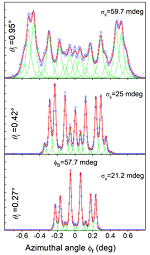 Elastic and inelastic diffraction of fast neon atoms on a LiF surface. Elastic and inelastic diffraction of fast neon atoms on a LiF surface.
Using recent progress in the description of the inelastic profiles we analyze the diffracted intensities of fast neon atoms on a LiF(001) surface along the [110] and [100] directions. Using the azimuthal profile recorded along a random direction where only the specular peak exists in the quantum regime, we show that diffracted intensities can be extracted even at comparatively large impact energies where coherence should be very limited. This is consistent with the fact that the linewidth exceeds the Bragg angle and washes out the rapid interferences. This analysis is discussed in term of a thermally averaged potential energy surface. -M. Debiossac, P. Pan, P. Roncin, "Lateral line profiles in fast-atom diffraction at surfaces", Phys. Chem. Chem. Phys. 25, 30966 (2023). |
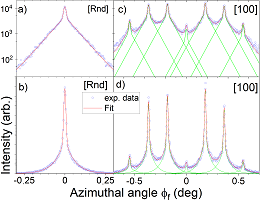 Lateral line profiles in fast-atom diffraction at surfaces. Lateral line profiles in fast-atom diffraction at surfaces.
As any diffraction technique, the structural information is hidden in the elastic diffracted intensities. In GIFAD, where all diffraction orders are recorded simultaneously, the accuracy is only limited by the small value of the Bragg angle leading to a frequent overlap of the inelastic contributions. All these aspects are analyzed from an experimental point of view with different analytic profiles. We provide evidences, that the inelastic lineshape evolves together with the "classical" energy loss starting from a pure exponential decay up to a quasi gaussian shape. -P. Pan, C. Kanitz, M. Debiossac, A. Le-Guen, J.N. Rad, P. Roncin, "Lateral line profiles in fast-atom diffraction at surfaces", Phys. Rev. B 108, 035413 (2023). |
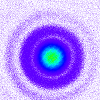
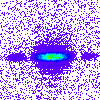
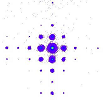 A setup for grazing incidence fast atom diffraction. A setup for grazing incidence fast atom diffraction.
This technical paper describes the specific arrangment of a setup devoted to fast atom diffraction. Several aspects are discussed with emphasis on the detection and imaging system. The use of a small laser for easy alignment, calibration and target positioning is also described. -P. Pan, J.N. Rad, P. Roncin, "A setup for grazing incidence fast atom diffraction", Rev. Sci. Inst. 93, 09355 (2022). |
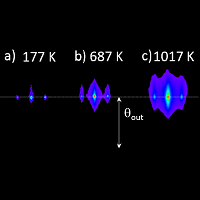 Temperature dependence in fast-atom diffraction at surfaces. Temperature dependence in fast-atom diffraction at surfaces.
One of the interesting properties of GIFAD is that it benefit from a specific Debye-Waller factor allowing operation at high temperature. This aspect is analysed in detail between 177 K and 1017 K. The topologic information carried by the relative intensities Im of the elastically diffracted peaks remains unchanged but its contribution weakens with temperature while the polar and lateral inelastic profiles become broader and more intense. -P. Pan, M. Debiossac, P. Roncin, "Temperature dependence in fast-atom diffraction at surfaces", Phys. Chem. Chem. Phys. 24, 12319-12328 (2022). |
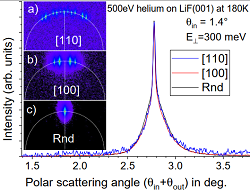 Polar inelastic profiles in fast-atom diffraction at surfaces. Polar inelastic profiles in fast-atom diffraction at surfaces.
Elastic diffraction of fast atoms at crystal surfaces under grazing incidence θ ≈ 1° has strong similarities with atomic diffraction at thermal energies discovered almost hundred years ago. Here, we focus on the polar scattering profile, which does not exhibit diffraction features but shows well-defined elastic and inelastic components that are found to be essentially independent of the crystallographic axis. The width σθ of the inelastic component is very sensitive to the weak attractive forces responsible for the physisorption. This effect is visible on an energy range almost ten times larger than the depth D of the physisorption well. Experimental data are analyzed using a binary collision model with a Morse potential where the width σθ of the scattering profile is connected to the classical energy loss and is governed by the surface stiffness, defined as the logarithmic derivative of the interaction potential along the surface normal. The main outcome is that the weak attractive forces make the mean surface potential almost twice harder at low energy. -P. Pan, M. Debiossac, P. Roncin, "Polar inelastic profiles in fast-atom diffraction at surfaces", Phys. Rev. B 104, 165415 (2021). |
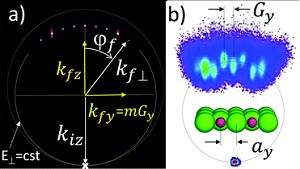 Grazing incidence fast atom diffraction, similarities and differences with thermal energy atom scattering (TEAS). Grazing incidence fast atom diffraction, similarities and differences with thermal energy atom scattering (TEAS).
Grazing incidence fast atom diffraction (GIFAD) at surfaces has made rapid progress and has established itself as a surface analysis tool where effective energy E> of the motion towards the surface is in the same range as that in thermal energy atom scattering (TEAS). To better compare the properties of both techniques, we use the diffraction patterns of helium and neon atoms impinging on a LiF (001) surface as a model system. E-Scan, y-scan, and f-scan are presented where the primary beam energy E is varied between a few hundred eV up to five keV, the angle of incidence theta between 0.2 and 2° and the azimuthal angle phi around 360°. The resulting diffraction charts are analyzed in terms of high and low values of effective energy E perpendicular. The former provides high resolution at the positions of the surface atoms and the attached repulsive interaction potentials while the second is sensitive to the attractive forces towards the surface. The recent progress of inelastic diffraction is briefly presented. -M. Debiossac, P. Pan, P. Roncin, "Grazing incidence fast atom diffraction, similarities and differences with thermal energy atom scattering (TEAS)", Phys. Chem. Chem. Phys. 23, 7615-7636 (2021). |
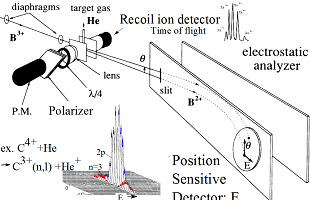 Revisiting atomic collisions physics with highly charged ions, a tribute to Michel Barat. Revisiting atomic collisions physics with highly charged ions, a tribute to Michel Barat.
Michel Barat passed away in November 2018 at the age of 80 after a rich career in atomic and molecular collisions. He had participated actively in formalizing the electron promotion model, contribuing to low energy reactive collisions at the frontier of chemistry. He investigated electron capture mechanisms by highly charged ions (HCI), switched to collision induced cluster dissociation and finally to UV laser induced fragmentation mechanisms of biological molecules. During this highly active time he created a laboratory, organized ICPEAC and participated actively in the administration of research. This paper covers the 10 years when he mentored my scientific activity in the blossoming field of electron capture by HCI. In spite of an impressive number of open channels, Michel found a way to capture the important parameters and to simplify the description of several electron capture processes ; orientation propensity, electron promotion, true double electron capture, transfer ionisation, transfer excitation, formation of Rydberg states, and electron capture by metastable states. Each time Michel established fruitful collaborations with other groups. -P. Roncin, "Revisiting atomic collisions physics with highly charged ions, a tribute to Michel Barat", J. Phys. B : At. Mol. Opt. Phys. 53, 202001 (2020). |
 Refraction of Fast Ne Atoms in the Attractive Well of a LiF(001) Surface. Refraction of Fast Ne Atoms in the Attractive Well of a LiF(001) Surface.
The attractive interaction between an atom and a surface is still a major challenge both for experiments and theory. This weak physisorption regime is responsible for the initial sticking on surface and may governs further chemical reaction. Analyzing the diffraction of neon atoms between 0.3 and 3 keV at grazing incidence, we noticed a clear increase of the lateral deflection at low energy whereas the opposite is expected from simple models, (being probed at larger distance the surface should appear more flat). We modeled this paradox by considering that the deflection close to the surface is mainly constant but that the observation angle is modified by the attractive forces. We have developed a quantum dynamics calculation that allowed us to fit an empirical interaction potential such that all observed diffraction orders could be reproduce quantitatively. Uusing different analytic forms of the potential, our optimization converged to the same potential energy depth. -M. Debiossac, P. Roncin, and A. G. Borisov, "Refraction of Fast Ne Atoms in the Attractive Well of a LiF(001) Surface", J. Phys. Chem. Lett. 11, 4564 (2020) |
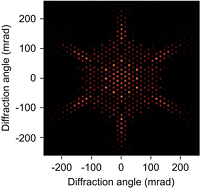 Coherent diffraction of hydrogen through the 246 pm lattice of graphene. Coherent diffraction of hydrogen through the 246 pm lattice of graphene.
We study the diffraction of neutral hydrogen atoms through suspended single-layer graphene using molecular dynamics simulations based on density functional theory. Although the atoms have to overcome a transmission barrier, we find that the de Broglie wave function for H at 80 eV has a high probability to be coherently transmitted through about 18% of the graphene area, contrary to the case of He. We propose an experiment to realize the diffraction of atoms at the natural hexagon lattice period of 246 pm, leading to a more than 400-fold increase in beam separation of the coherently split atomic wave function compared to diffraction experiments at state-of-the art nano-machined masks. We expect this unusual wide coherent beam splitting to give rise to novel applications in atom -C. Brand, M. Debiossac, T. Susi, F. Aguillon, J. Kotakoski, P. Roncin, M. Arndt, "Coherent diffraction of hydrogen through the 246 pm lattice of graphene", New J. Phys. 21, 033004 (2019) |
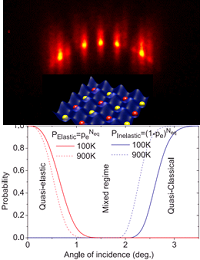 Lamb-Dicke regime of recoilless emission. Lamb-Dicke regime of recoilless emission.
Atomic diffraction spots have two component, one is point-like corresponding to elastic scattering, the other one, the inelastic component, is broader and consist here in here in vertical stripes pointing upward or downward. We derive a collisional model where the momentum exchange with each surface atom is modeled as a harmonic oscillator and we evaluate the probability for the collision to be associated with a vibrational excitation. We draw an analogy between the absence of energy exchange and the recoil-less emission probability (Lamb-Dicke) used for instance in optical lattices (insert). The line shape of the inelastic profiles are given by an analytic statistical treatment predicting the existence of a mixed regime between the quantum and classical regime. The energy loss is predicted to exhibit a θ7 dependence with the angle of incidence θ. -M. Debiossac and P. Roncin " Elastic and inelastic diffraction of fast atoms, Debye-Waller factor and Mössbauer-Lamb-Dicke regime", Phys. Rev. B 96, 035415 (2017). |
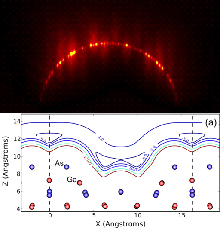 High resolution imaging of the β2(2×4) reconstructed GaAs(001) surface. High resolution imaging of the β2(2×4) reconstructed GaAs(001) surface.
Scattering pattern of 400 eV helium atom diffracted from a GaAs surface at 600°C directly inside a molecular beam epitaxy chamber (MBE) at INSP (Paris). The high quality of the freshly grown surface has produced very rich diffraction images made of 100 spots perfectly located on the Laue circle of energy conservation. Combined with a "state of the art" theoretical calculation of the GaAs surface and a quantum scattering code the surface electronic density is produced. The lateral resolution is estimated below 0.1 Å and the vertical one is even better. -M. Debiossac, A. Zugarramurdi, H. Khemliche, P. Roncin, A. G. Borisov, A. Momeni, P. Atkinson, M. Eddrief, and F. Finocchi and V. Etgens. " Combined experimental and theoretical study of fast atom diffraction on the β2(2×4) reconstructed GaAs(001) surface", Phys. Rev. B 90, 155308 (2014). |
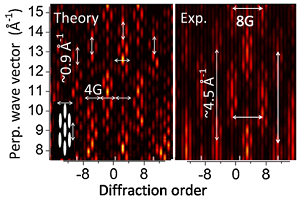 Exact quantum scattering and model calculations. Exact quantum scattering and model calculations.
We have progressively learned how to interpret qualitatively our data. By assembling on a single image the elastic diffraction intensities recorded as a function of the angle of incidence we construct a "diffraction chart". To first order, it corresponds to a simple wavelength variation on a given grating. This provides a high redundancy as well as specific features such as the chain pattern depicted in white and appearing periodically on the data. It is well reproduced by exact theory and experiment and well understood by simple optical models with only few rays per lattice unit. M. Debiossac, P. Atkinson, A. Zugarramurdi, M. Eddrief, F. Finocchi, V.H. Etgens, A. Momeni, H. Khemliche, A.G. Borisov, P. Roncin, " Fast atom diffraction inside an MBE chamber, a rich combination", Appl. Surf. Science. 391, 53 (2017) |
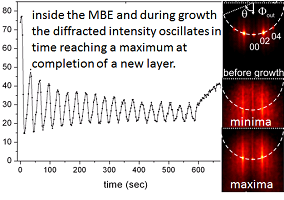 GIFAD inside MBE during growth. GIFAD inside MBE during growth.
At INSP Paris, GIFAD was able to track, layer by layer the homo-epitaxial growth of GaAs by observing intensity oscillations similar to those obtained in RHEED. After a systematic analysis of the shape of the oscillation and their positions, P. Atkinson established that the oscillations are independent on the projectile energy, angle of incidence and observation direction. They are very robust and probably due to simple oscillations of the surface reflectivity, i.e. without any interference from sub-layer, as the atoms do not penetrate the topmost layer. P. Atkinson, M. Eddrief, V. H. Etgens, H. Khemliche, M. Debiossac, A. Momeni, M. Mulier, B. Lalmi and P. Roncin, “Dynamic grazing incidence fast atom diffraction during molecular beam epitaxial growth of GaAs”, Appl. Phys. Lett. 105, 021602 (2014). |
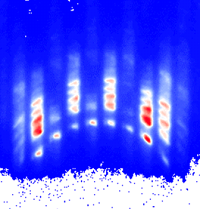 Twist and tilt around the surface. Twist and tilt around the surface.
GIFAD demonstrated to be extremely sensitive to the presence of mosaic domains. These are monocrystalline domains separated by dislocations probably induced by thermal shocks. They are tilted in-plane or out of plane (fig.) by less than 0.1 deg. easily resolved in GIFAD. Here the tilted domains produce difference Laue circles and the diffraction spots appear as short segments. The surface illuminated by the GIFAD beam is one the order of a mm2 (0.1mm*10mm). article : B Lalmi, H Khemliche, A Momeni, P Soulisse and P Roncin, "High-resolution imaging of superficial mosaicity in single crystals using grazing incidence fast atom diffraction", J.Phys. Condens. Matter 24, 442002 (2012) |
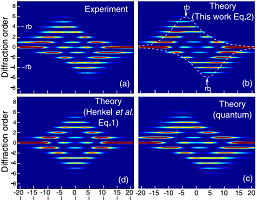 GIFAD in misaligned conditions. GIFAD in misaligned conditions.
We were not prepared to the crystallographic sensitivity of GIFAD that require accuracy around few/100 of deg. After quantum calculation where time reversal was used to connect different initial conditions. Following a paper by C. Henkel et al. on cold atom diffraction by a standing waves grating, M. Debiossac was able to derive a semi-empirical model forcing time reversal symmetry allowing, for simple systems, an analytic prediction (top right image) of the diffracted intensities in misaligned conditions. -A. Zugarramurdi, M. Debiossac, P. Lunca-Popa, L. S. Alarcon, A. Momeni, H. Khemliche, P. Roncin, and A. G. Borisov, " Surface-grating deflection of fast atom beams ", Phys. Rev. A 88, 012904 (2013). |
 Moiré pattern of SiC grown graphene. Moiré pattern of SiC grown graphene.
We have analyzed with GIFAD a graphene layer epitaxially grown on SiC (A. Mayne). The moiré pattern of the 13x13 superlattice is directly observed along the armchair direction with an estimated amplitude of 0.14 Å. The corrugation of the C-C backbone is only observed along the zigzag direction. -M. Debiossac, A. Zugarramurdi, Z. Mu, P. Lunca-Popa, A. J. Mayne, and P. Roncin “Helium diffraction on SiC grown graphene : Qualitative and quantitative descriptions with the hard-corrugated-wall model”, Phys. Rev. B 94, 205403 (2016). -A. _ -Zugarramurdi, M. Debiossac, P. Lunca-Popa, A. J. Mayne, A. Momeni, A. G. Borisov, Z. Mu, P. Roncin, and H. Khemliche, " Determination of the geometric corrugation of graphene on SiC(0001) by grazing incidence fast atom diffraction", Appl. Phys. Lett. 106, 101902 (2015) |
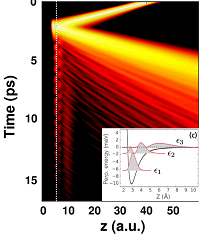 Bound state resonances at the surface. Bound state resonances at the surface.
Since 1933 (O. Stern, J.E. Lennard-Jones), bound state resonances at crystal surfaces are known to appear when the energy associated with a given diffraction order matches that of a bound state on the surface. The projectile can be trapped and released only when close to the turning point. These provide the most accurate determination of the weak van der Waals forces. However, observing few meV deep bound states with keV projectile was a tour de force. With help of theory (wave packet propagation in fig.), we understood that these resonances are extremely sensitive to surface coherence (distance between defects) on the micron scale. In GIFAD, the projectile velocity is so large that the distance spanned during vibration period is a fraction of a micron. article : M. Debiossac, A. Zugarramurdi, P. Lunca-Popa, A. Momeni, H. Khemliche, A. G. Borisov, and P. Roncin, “Transient Quantum Trapping of Fast Atoms at Surfaces” Phys. Rev. Lett. 112, 023203 (2014). |
 Atom beam triangulation of molecular layer. Atom beam triangulation of molecular layer.
Molecular layers tend to have much less coherence length limiting the observation of clear diffraction patterns. To avoid remain blind we have derived a new technique where the fwhm of the structure less scattering profile (insert) is recorded as a function of the azimuthal angle φ. This simple azimuthal diagram shows pronounced peaks indicating, at this angle φ the presence of valleys. This is enough to reveal the directions where molecules start to align with each other even with limited coherence. Work is in progress to analyze the line shape more accurately for a possible link to surface properties. article : Nataliya Kalashnyk, Hocine Khemliche and Philippe Roncin, “Atom beam triangulation of organic layers at 100 meV normal energy : self-assembled perylene on Ag(110) at room temperature” . Appl. Surf. Science. 364, 235 (2016). |
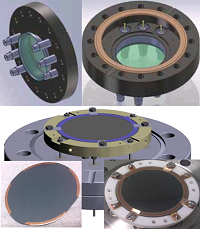 Compact imaging detectors for diffraction and time of flight measurments. Compact imaging detectors for diffraction and time of flight measurments.
Two different imaging detectors have been developed ; both rely on microchannel plates to convert an atom impact into an electron cascade. The one on top offers 70mm open surface on a CF100 flange and offer high resolution together with high repetition rate. It is used with one or two MCP to record diffraction pattern. The one below has 40mm active area on a CF63 flange and is a single particle detector with sub-ns resolution and 100µm resolution but count rates limited to few kHz. It is a well-suited for position resolved time of flight measurements. It has been designed for mass analysis of the compound at the surface. article : -Sylvain Lupone, Pierre Soulisse and Philippe Roncin, “A large area high-resolution imaging detector for fast atom diffraction.” . NIM-B 427, 95 (2018). |
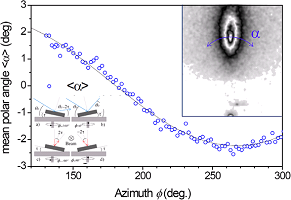 Active control of the surface plane. Active control of the surface plane.
Dealing with incidence angle on the order of a degree is associated with technical difficulties. The sample transfer under UHV as well a the precise crystal positioning is usually performed within a degree. We have developed an automated servo control of the surface plane during azimuthal rotation in UHV to favor Atom beam triangulation measurement. article : M. Sereno, S. Lupone, M. Debiossac, N. Kalashnyk, P. Roncin, “Active correction of the tilt angle of the surface plane with respect to the rotation axis during azimuthal scan” . NIM-B. 382, 123 (2016). |
Sous-rubriques :


